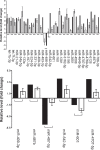Human microRNA expression in sporadic and FAP-associated desmoid tumors and correlation with beta-catenin mutations
- PMID: 28418912
- PMCID: PMC5522034
- DOI: 10.18632/oncotarget.16383
Human microRNA expression in sporadic and FAP-associated desmoid tumors and correlation with beta-catenin mutations
Abstract
Desmoid tumors (DT) are rare, benign, fibroblastic neoplasm with challenging histological diagnosis. DTs can occur sporadically or associated with the familial adenomatous polyposis coli (FAP). Most sporadic DTs are associated with β-catenin gene (CTNNB1) mutations, while mutated APC gene causes FAP disease. microRNAs (miRNAs) are involved in many human carcinogenesis.The miRNA profile was analyzed by microarray in formalin-fixed, paraffin-embedded (FFPE) specimens of 12 patients (8 sporadic, 4 FAP-associated) and 4 healthy controls. One hundred and one mRNAs resulted dysregulated, of which 98 in sporadic DTs and 8 in FAP-associated DTs, 5 were shared by both tumors. Twenty-six miRNAs were then validated by RT-qPCR in 23 sporadic and 7 FAP-associated DT samples matched with healthy controls. The qPCR method was also used to evaluate the CTNNB1 mutational status in sporadic DTs. The correlation between sporadic DTs and miRNA expression showed that miR-21-3p increased in mutated versus wild-type DTs, while miR-197-3p was decreased. The mRNA expression of Tetraspanin3 and Serpin family A member 3, as miR-21-3p targets, and L1 Cell Adhesion Molecule, as miR-197-3p target, was also evaluate. CTNNB1 mutations associated to miRNA dysregulation could affect the genesis and the progression of this disease and help histological diagnosis of sporadic DTs.
Keywords: CTNNB1 mutations; desmoid tumor; microRNA; serpin family A member 3 (SERPINA3) mRNA; tetraspanin3 (TSPAN3) mRNA.
Conflict of interest statement
All authors declare that there are no conflicts of interest.
Figures



Similar articles
-
CTNNB1 genotyping and APC screening in pediatric desmoid tumors: a proposed algorithm.Pediatr Dev Pathol. 2012 Sep-Oct;15(5):361-7. doi: 10.2350/11-07-1064-OA.1. Epub 2012 Feb 28. Pediatr Dev Pathol. 2012. PMID: 22372443
-
FAP-related desmoid tumors: a series of 44 patients evaluated in a cancer referral center.Histol Histopathol. 2012 May;27(5):641-9. doi: 10.14670/HH-27.641. Histol Histopathol. 2012. PMID: 22419028
-
Identification of Familial Adenomatous Polyposis carriers among children with desmoid tumours.Eur J Cancer. 2012 Aug;48(12):1867-74. doi: 10.1016/j.ejca.2012.01.004. Epub 2012 Feb 2. Eur J Cancer. 2012. PMID: 22305464
-
Desmoid Tumors in Familial Adenomatous Polyposis.Anticancer Res. 2017 Jul;37(7):3357-3366. doi: 10.21873/anticanres.11702. Anticancer Res. 2017. PMID: 28668823 Review.
-
[Progress in the research of pathology and genetics of desmoid tumor].Zhonghua Bing Li Xue Za Zhi. 2005 Aug;34(8):537-9. Zhonghua Bing Li Xue Za Zhi. 2005. PMID: 16383304 Review. Chinese. No abstract available.
Cited by
-
Novel insights into biomarkers of progression in Desmoid tumor.Front Oncol. 2023 Aug 3;13:1206800. doi: 10.3389/fonc.2023.1206800. eCollection 2023. Front Oncol. 2023. PMID: 37601698 Free PMC article. Review.
-
MicroRNAs regulating Wnt signaling pathway in colorectal cancer: biological implications and clinical potentials.Funct Integr Genomics. 2022 Dec;22(6):1073-1088. doi: 10.1007/s10142-022-00908-x. Epub 2022 Oct 20. Funct Integr Genomics. 2022. PMID: 36264397 Review.
-
A Rare Paraspinal Desmoid Tumour following Instrumented Scoliosis Correction in an Adolescent.Case Rep Orthop. 2021 Feb 22;2021:6665330. doi: 10.1155/2021/6665330. eCollection 2021. Case Rep Orthop. 2021. PMID: 33688443 Free PMC article.
-
Intraabdominal sporadic desmoid tumors and inflammation: an updated literature review and presentation and insights on pathogenesis of synchronous sporadic mesenteric desmoid tumors occurring after surgery for necrotizing pancreatitis.Clin Exp Med. 2023 Jul;23(3):607-617. doi: 10.1007/s10238-022-00849-6. Epub 2022 Aug 1. Clin Exp Med. 2023. PMID: 35913675 Free PMC article. Review.
-
Restorative perineal anorectal amputation for a locally advanced desmoid tumour.Int J Colorectal Dis. 2020 Jul;35(7):1333-1334. doi: 10.1007/s00384-020-03598-8. Epub 2020 May 1. Int J Colorectal Dis. 2020. PMID: 32358720 No abstract available.
References
-
- Fletcher JA, Bridge JA, Hogendoorn PCW. WHO Classification of Tumors of Soft Tissue and Bone. Lyon: IARC Press; 2013. Desmoid-type fibromatoses; pp. 72–73.
-
- Schlemmer M. Desmoid tumors and deep fibromatoses. Hematol Oncol Clin North Am. 2005;19:565–571. - PubMed
-
- Clark SK, Phillips RKS. Desmoids in familial adenomatous polyposis. Brit J Surg. 1996;83:1494–1504. - PubMed
-
- Kasper B, Baumgarten C, Bonvalot S, Haas R, Haller F, Hohenberger P, Moreau G, van der Graaf WT, Gronchi A, Desmoid Working Group Management of sporadic desmoid-type fibromatosis: a European consensus approach based on patients’ and professionals’ expertise - a sarcoma patients EuroNet and European Organization for Research and Treatment of Cancer/Soft Tissue and Bone Sarcoma Group initiative. Eur J Cancer. 2015;51:127–136. doi: 10.1016/j.ejca.2014.11.005. - DOI - PubMed
MeSH terms
Substances
Supplementary concepts
LinkOut - more resources
Full Text Sources
Other Literature Sources
Molecular Biology Databases
Miscellaneous

